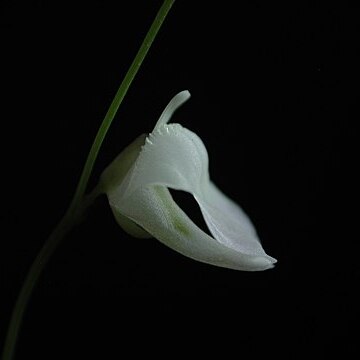Terrestrial herb.. Rhizoids and stolons capillary, usually numerous from the base of the scape.. Leaves not always present nor conspicuous at anthesis, subrosulate at the scape-base and scattered on the stolons, linear to obovate-spathulate or rarely reniform, 1–7 cm. long, 1–6 mm. wide; nerves of the lamina usually dichotomously branched.. Traps numerous, ovoid, 1–2 mm. long, stalked; mouth terminal; upper lip projecting about twice as much as the lower, both provided with radiating rows of glandular hairs.. Inflorescence erect, straight or flexuous, simple or rarely branched above, 2–80 cm. high; scape smooth and glabrous, relatively robust; flowers (1–)2–8(–50), distant or more rarely congested; scales few, similar to the bracts; bracts basifixed, ovate, acute or acuminate, ± 1 mm. long; bracteoles linear-lanceolate, ± as long as the bract; pedicels 0.5–1(–3) mm. long, erect at anthesis, spreading or reflexed in fruit.. Calyx-lobes subequal, ovate, 2–3 mm. long at anthesis, accrescent, always plicate along the nerves, apex of upper lobe acute or obtuse, of lower lobe rounded, truncate or ± bidentate.. Corolla violet, mauve or white with a yellow spot on the palate or more rarely wholly yellow or cream, 5–15 mm. long; upper lip 1.5–2 times as long as the upper calyx-lobe, narrowly oblong-obovate, apex rounded or truncate; lower lip orbicular; palate raised and double crested, the crests usually transversely tuberculate; spur slightly shorter than to about 1 1/2 times as long as the lower lip, conical-subulate, straight or curved.. Filaments linear; anther-thecae subdistinct.. Ovary globose; style short but distinct; stigma lower lip semi-orbicular, upper much smaller, deltoid.. Capsule globose, up to 2 mm. long, dehiscing by ab-and adaxial longitudinal slits with thickened margins.. Seeds few to many, 0.3–0.5 mm. long, ovoid, slightly angular, smooth or obscurely to distinctly papillose; testa-cells indistinct, elongate.
Annual or perennial, carnivorous herb. Leaves: blade narrowly cuneiform to reniform, several-to many-veined. Traps ovoid, mouth terminal. Flowers in a branched or simple raceme, 20-80 mm long; shades of violet, sometimes with yellow palate, or wholly yellow or white. Calyx: lobes Sub-Equal or unequal, ovate, pleated along 5-7 veins. Corolla: upper lip narrowed above middle; lower lip ± circular; spur equal to or up to 2x length of lower lip. Flowering time Sept.-Apr., mainly Jan.
Terrestrial herb. Leaves narrowly obovate to spathulate, 2-70 mm long, several to many veined. Flowers: bracteoles present, bracts not > twice as wide as bracteoles and similar in shape; base of peduncle glabrous; corolla with spur ± equal to or at most one and a half times as long as lower petal lip; 6-15 mm long, violet, mauve or white with yellow spot on palate or more rarely wholly yellow or cream-coloured; Jul.-Jun. Traps ovoid, 1-2 mm long.
Corolla violet, mauve or white with a yellow spot on the palate or more rarely wholly yellow or cream, 5–15 mm. long; superior lip 1.5–2 times as long as the upper calyx lobe, narrowly oblong-ovate, with apex rounded or truncate; inferior lip circular; palate raised and double crested, the crests usually transversely tuberculate; spur slightly shorter than to about 1.5 times as long as the inferior lip, conical-subulate, straight or curved.
Inflorescence erect, straight or flexuous, simple or rarely branched above, 2–80 cm. high; smooth and glabrous, relatively robust; flowers (1)2–8(50), distant or more rarely congested; scales few, similar to the bracts; bracts basifixed, ovate, acute or acuminate, more or less 1 mm. long; bracteoles linear-lanceolate, more or less as long as the bract; pedicels 0.5–1(3) mm. long, erect at anthesis, spreading or deflexed in fruit.
Leaves not always present nor conspicuous at anthesis, subrosulate at the peduncle base and scattered on the stolons, linear to obovate-spathulate or rarely reniform, 1–7 cm. long, 1–6 mm. wide; nerves of the lamina usually dichotomously branched.
Calyx lobes subequal, ovate, 2–3 mm. long at anthesis, accrescent, always plicate along the nerves, with apex of the upper lobe acute or obtuse, of lower lobe rounded, truncate or more or less bidentate.
Seed few to many, 0.3–0.5 mm. long, ovoid, slightly angular, smooth or obscurely to distinctly papillose; testa-cells indistinct, elongate.
Traps numerous, ovoid, 1–2 mm. long, stalked; mouth terminal, provided with dorsal and ventral radiating rows of glandular hairs.
Capsule globose, up to 2 mm. long, dehiscing by dorsal and ventral longitudinal slits with thickened margins.
Ovary globose; style short but distinct; stigma inferior lip semi-circular, superior much smaller, deltoid.
Rhizoids and stolons capillary, usually numerous from the base of the peduncle.
Filaments linear; antherthecae subdistinct.
Terrestrial herb.


